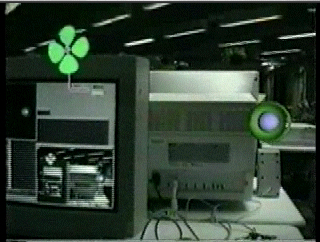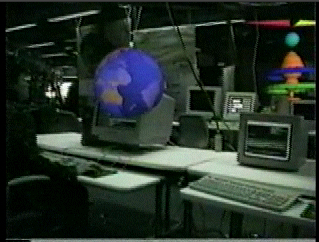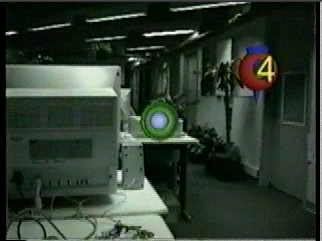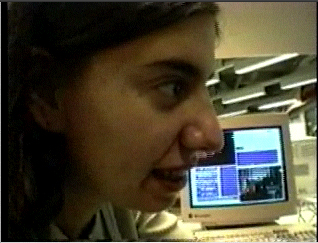Karrie Karahalios, MIT
Media Lab Researcher, Sociable Media Group
Developed DIORAMA an 'augmented
reality' system which enables 3D objects to appear to those looking at a laptop
screen to float over the top
of the real world, and
be linked to actual sites and objects in the real world.
Diorama is the formative step toward full Augmented Reality - enabling virtual
information to be available to people as 3D shapes, signage or architecture
which appears superimposed over a view of the real world.
I worked with Karrie Karahalios on developing 3D dynamic floating signs for
Diorama and symbols. These are 3D shapes which float over the user's field
of view so that information about the surrounding environment can be made
available in real time.Thes were designed to assist in enabling a person to
visualize such things as the flow of ethernet traffic around the lab, number
and rate of emails arriving, directions and locations of objects in the room
such as doors, fridges, parts of the building etc.
The 3D shapes represent a new category of urban signage in which architecture
can be overlaid electronically over the real city. This ties in with an examination
of the role and function of urban signage, and city based information structures
such as facades and marquees. Augmented Reality would enable people to configure
their views of the world around them, and would enable them to modify views
of the physical space to assist them in many ways:
While working at the Media Lab Prof. William J Mitchell and Judith Donath
recommend I develop an essay on the subject of signage from a historical/archeological
perspective.
|
|
|
Video Interview
with Karrie Karahalios, colleague at the MIT
Media Lab with whom I worked on the "Diorama" project.
Here Karrie explains the workings of Diorama, and how the dynamic signs
within it relate to real world phenomena. As designer of the 3D floating
VRML shapes, I needed to work closely with Karrie for two months in
1998 to identify what types of shapes would be needed and how they would
need to relate to the world around them. I used the software 3D studio
release 3 to generate the shapes.
|
The VRML
virtual signage was designed to be of small file size, to enable rapid rendering,
and in some cases, animated dynamically to reflect changes in events in the
actual environment. The green windmill for example rotates more quickly and
slowly depending upon the data rate of of traffic across the ethernet network.
I was excited to be working on DIORAMA as it closely resembled the fictional
role played by 'netspex' in my 1998 short film
"Otherzone". In the image below "Navigating with Diorama"
note the 3D floating mail box. The blue ball floating next to the tubular
mailbox represents a single email. The flag is up and the door open to reveal
the arrival of a new email.
In the top
right image above, the shape on the left is a digital totem pole, which lets
the user 'stack' media in a pile, so that it can be accessed when needed.
The bottom left hand picture shows a number '4' floating near a door which
is also number 4 in the real world. Floating 3D 'post-it note' type markers
act as waystations to specific locations within a room. In the video interview
sequence, the Diorama camera sees the refrigerator, over which Karrie has
placed a 'reminder' marker: it was to remind her to eat after staying up all
night debugging the system.
The cross
shape (pictured bottom left below) with a different coloured polygon on each
end is based on a directional sign at a crossroads, as well as a traditional
weathervane. Each colour coded object points to another like it in the direction
it is pointing in. Hence, the yellow sphere points to another yellow sphere
down the corridor. Similarly 'blue cone' points a 'blue cone' region nearby
etc. Signage of this sort could appear only to one user, or to all users.
3D augmented reality is configurable and personalisable. Just as people customise
their computer desktops, and cellular phones, the Diorama system would let
users edit and assemble and build from kits of parts their own 3D signage
with which to elucidate aspects of the surrounding environment, For example
should one want to block out the view of the McDonald's golden arches, the
user of an advanced "Diorama" could 'blot out' the golden arches,
even replace them with say, the Mona Lisa.

Uses of Untethered Augmented Reality Signage.
Navigation
The system could show you where you were in relation to other places, or show
you where objects were that you had lost by those objects being tagged in
such a way as to send a signal which you could detect visually.
"Labeling" areas of interest - users can 'tag' reality like "post-it notes"
Communicating with Others
Shared views of the city could be done collaboratively and just as the web
today enables us to share information globally, so could augmented reality
enable us to share, literally our world views or views of the world around
us.
This would radically alter the current role of physically based information
structures. Billboards, ads, posters, signs on doors, walls, elevators etc
could be buttressed and even replaced by virtual signage.
This suggests whole new design paradigms are required which take into account
the fact that signage can be made geospatially context specific, unique to
a person's physical and geographic position, and his position in relation
to other people.
Signage can also reflect dynamism in the world itself - the flow of phenomena
such as traffic, weather, population, available car parking spaces etc.
Types of Signage include Directional, Instructional, Regulatory, Warning signs
can appear in the user's field of view instead of being affixed to the landscape
itself.
A syntax of 3D signage is desirable a kind of lexicon of shapes and objects
which fit together in terms of containing within their overall design a consistency
of appearance, meaning and function. A kit-like structure like "Lego".
New questions which this research has brought forward:
* What design principles are involved in the development of signage which
displays dynamic phenomena in an urban space?
* What is the best way to design 3D shapes and signs designed for use with
Augmented Reality such that this signage can be personalized, and also made
to interact with the physical environment in real time?
* In enabling people to personalise their urban spaces, whether online as
in
the case of EMUGRID, or via augmented reality as in the case of Diorama,
what are the likely effects of these types of wireless communication forms
on the city itself? How might society be affected by the development of
media forms characterised by intimate interaction with physical space, which
are worn or embedded into the environment itself?





